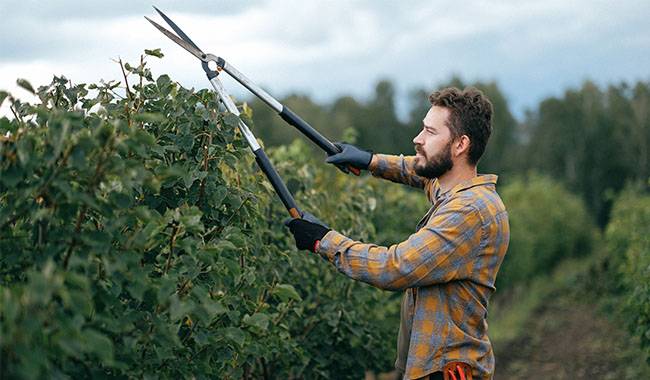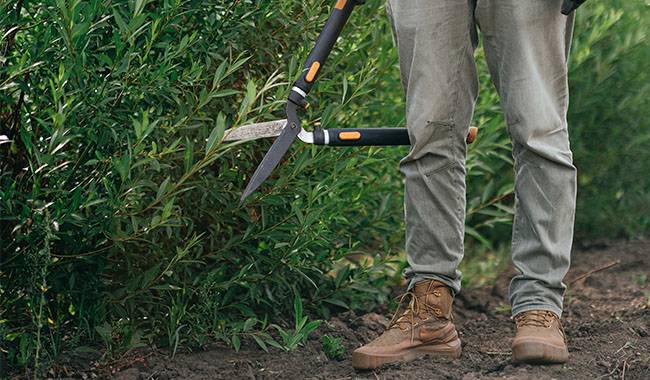
Any garden is a small part of the fruit plants. Usually, in order to grow them, we buy summer cabins, equip private land, and go out of town to live.
Apple trees, pears, grapes, hazelnuts, and somewhere persimmons, dogwoods, figs all please us with their fruits, and in gratitude, we take care of them. Fruit trees and shrubs should never be neglected in autumn.
After all, it is during the autumn months that there is time for some activity, which will promote trouble in the spring. And in this case, one of the most time-consuming techniques is fall pruning.
GENERAL RULES OF FALL PRUNING
Autumn pruning has its own rules and it is very important to know them. Thus, the middle belt and more northern regions are characterized by cold winters, so in these areas, for most crops, in late autumn it is only acceptable to remove dry, diseased, and mechanically damaged branches.
But for the south, sanitation and rejuvenation, as well as plastic pruning, are appropriate. Let’s see how they are done and which fruit plants are recommended or accepted in the fall.
When to do fall pruning?
Fall pruning, like spring pruning, is done during the dormant period of the plant. This time comes when the leaves fall from the trees.
To perform these operations, choose a dry, sunny day with a temperature reading of no less than 23°F (-5°C), or even better – before starting the jump from positive to negative temperatures.
Scissors, saws, and shears should be sharpened to minimize damage to the wood and sterilized. A ladder should be on hand, along with garden punch or garden paint.
Hygienic pruning
Can be used universally and is preferred even in the fall. This includes removing dry, diseased, broken branches and branches that do not bear fruit because they are heavily shaded.
Formative pruning
Has the purpose of forming a tree canopy with sufficient light, maximum productivity, and good ventilation. It is also used to control the height, form, and density of trees and shrubs, to stimulate the growth and development of lateral branches, and to control the fruit load.
Rejuvenating pruning
It is applied to mature trees and shrubs to stimulate the formation of new shoots, capable of replacing old unproductive ones.
Autumn pruning techniques
Annual shoots and fine branches should be cut at an angle. Thick branches: cut them into rings without stumps. To achieve a clean-cut, anything larger than a thumb should be sawed off from the bottom first, then the top side, and then the branch bent toward the first cut.
If you need to remove several very thick branches from a tree, you should not remove more than two at a time. Likewise, during rejuvenation pruning, do not cut all the intended branches at once, but distribute the process over several seasons.
Diseased branches are pruned to healthy ones with a pruning length of 0.8-1.6inch (2-4 cm).
Plants one to two years old are not pruned in autumn.
CHARACTERISTICS OF AUTUMN PRUNING OF POPULAR FRUIT CROPS

Currants
Currants are one of the few crops that are recommended for fall pruning. This is because the buds on currants wake up very early when it is still difficult to enter the garden due to the mud caused by the spring thaw.
In addition to sanitary pruning, currant bushes should be shaped immediately in the fall to rejuvenate them. Remove shoots that point deep into the canopy, intertwined with each other and adjacent to the ground.
Cut off branches that are more than 5 years old. Make sure that the bush consists of branches of different ages since only branches of 3-6 years old will actively flower and bear fruit.
If a cut gooseberry branch is black in the middle, it indicates that the plant is infested with current glasswort. Such shoots are cut off near the ground and burned off.
Red currant and white currant
For red and white currants, the most suitable time for pruning is autumn, due to the early flowering, as well as the currants. When the foliage ends, check the bush, remove branches older than 8 years and rejuvenate the plant and branches growing under 6inch (15cm).
If there is a black middle on a cut branch, a sign of current glasswort infestation, the shoot will be cut and burned from the very bottom.
Black currant
In the fall, on black currants, remove those that are diseased, bent, adjacent to the ground, and directly into the bush. Cut off branches that are more than 3 years old. Perform thinning.
After pruning, the blackcurrant crown should include 9-12 shoots, some of which are annuals and some ineffective. This method will allow you to slow down the aging of the bush and prolong its productivity.
Bilberries
If bilberries are not cut back early, in the fall, remove any shoots that are fruit-bearing that year, affected by bilberry stem fly, bilberry stem moth, bilberry kidney moth, broken off for some reason, or stunted. The bush is thinned, leaving 4-7 shoots.
In some cases, the above-ground parts of the replanted varieties were completely cut off, thus improving their next harvest.
Kiwifruit
Do not prune the Actinidia until it has shed all its leaves. This is usually when the temperature has stabilized below freezing. First, remove any dry, diseased, broken, or drooping branches by shortening them to the 2nd live bud.
Then, to rejuvenate the bush, 1-2 and 3-year-old branches are cut off. Finally, all growing branches are shortened by 20inch (50 cm) and mixed branches by 12inch (30 cm).
These are the general rules. However, actinomycetes are an ambiguous culture and it is necessary to be guided by the species of this plant when pruning it.
Thus, when the canopy is well thinned and shoots are regularly shortened, Actinidia arguta increases its production. For Actinidia colorectal, shortening is only recommended when the plant is 7-10 years old, and older vines are best replaced by younger ones.
However, Actinidia paligamma does not tolerate the pruning of fruiting branches and responds to such pruning with a sharp decrease in yield.
Grapes
The practice of pruning grapes in autumn is carried out in a sheltered cultivated area before covering for the winter. For this purpose, first, a hygienic pruning is carried out, then the vines are cut according to the chosen principle (buds are kept on frostbitten shoots and the final pruning is carried out in spring).
More often than not, the principle of forming replacement knots on 3-5 shoots and fruit arrows on 8-10 shoots, as well as removing extreme vertical shoots, is applied.
Edible honeysuckle
Edible honeysuckle should be pruned every few years. Shorten the length of the shoots. Remove any twining shoots. Thinning out. Cut off anything that points to the ground and obstructs neighboring crops. branches over 7 years old are cut into 2inch (5cm) stumps. After pruning, the honeysuckle bush should form 6-8 full branches.
Blackberry
In autumn, in addition to hygienic pruning, blackberry needs bush shaping, all because she bears fruit on two-year-old shoots. In order that the bush does not grow full of unproductive branches after fruiting, they are removed.
In addition, everything that was weak and stunted was cut off, leaving only 8-10 fully grown shoots in the bush. Finally, all mature shoots are shortened by about 1/4 to encourage the formation of reproductive shoots.
Lemongrass
Lemongrass needs to be pruned in the fall. After leafing out, weak, dry shoots are removed. Thinning of bushes. Cut the vines, which bear fruit for more than three years. The height of the plant is shaped, but the shortening of the mixed branches does not exceed 12inch (30 cm).
Hazel with Hazelnut
Not only annual sanitary pruning but also thinning pruning is important for Hazel & Hazelnut. The bushes have a tendency to overgrow, so remove them and make them cry, and break, and thicken branches.
These crops have a long life span. Capable of bearing fruit for more than 80 years. Therefore, plants that are already more than 20 years old must be gradually rejuvenated. For this reason, 1-2 old branches should be cut off every year to make room for younger branches.
Apple trees
Spring is considered the best time to prune apple trees, but if there is not enough time for spring pruning, fall pruning is allowed in the south and intermediate zones, especially for frost-resistant varieties.
Apple trees should only be pruned after the leaves have fallen off, and it is recommended that this process be completed before temperatures around 23°F (-5°C) because, with the onset of frost, the wood becomes brittle and fragile and loses its ability to tighten quickly.
First, dry branches, diseased, broken, intertwined, and those growing within the canopy are removed from the tree.
Spindle-shaped branches, branches growing below the first level of scaffold branches, branches growing at acute angles (less than 45°), and previously unnoticed competing branches are cut to rings.
The rest (rejuvenating pruning, techniques to stimulate fruit tree formation and branching) should be postponed until spring.
Pears
Pruning pears in autumn is mainly for sanitary purposes. In this case, early ripening varieties should be cut in late August to September, late-ripening varieties can be postponed to later, but not later than the temperature starts to “jump” from positive to negative numbers.
In sub-zero temperatures, the wood of pear trees is less suitable for pruning, the tightness of the cuts is poor and therefore infection may start to appear.
On mature plants, remove dry, broken branches and shoots with signs of dangerous diseases (cancer). Remove growths at right angles to the trunk and strong spikes that are not fertile.
If it is necessary to remove a large old branch, the pruning procedure is divided into several stages, extending over several seasons, because if you remove everything at once – it will weaken the plant before winter.
In autumn, restorative pruning of pear trees is also carried out. By the third of the year, the crown is lowered and the skeletal branches become thinner. The result of pruning is that 5-8 main branches should be left on the tree, arranged in two layers.
For cherries, plums, apricots, peaches, cherry plums, sea buckthorn, quince, it is recommended to perform only sanitary pruning in autumn.







